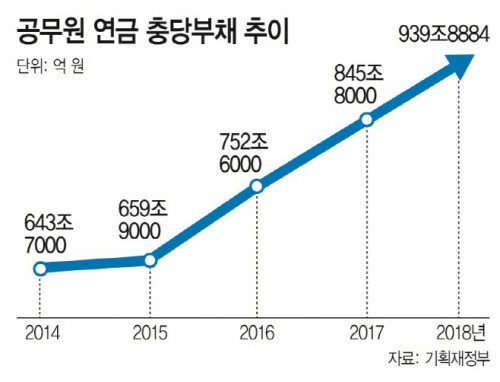 |
| South Korea’s state liabilities reached 1,682.7 trillion won in 2018, up 126.9 trillion won from a year earlier, according to a data announced by the Ministry of Strategy and Finance on Tuesday. |
By AsiaToday reporter Yoo Jae-hee
South Korea’s national debt is rising fast, worsening its financial health. Its national debt hit a record high last year, exceeding 1,680 trillion won. In particular, pension liabilities, which have increased 100 trillion won every year, reached nearly 940 trillion won last year due to the growing number of civil servants and soldiers. However, the government is continuing its push to hire a massive number of public sector workers.
The country’s state assets amounted to 2,123.7 trillion won and liabilities reached 1,682.7 trillion won in 2018, according to a data announced by the Ministry of Strategy and Finance on Tuesday.
Among the total national debt last year, more than half of the debt came from the government and regional offices’ obligations to pay their employees and finance their pensions. The problem is that pension liabilities have increased by nearly 100 trillion won for the past three years. Pension liabilities amounted to 752.6 trillion won in 2016, 845.8 trillion won in 2017, and 939.9 trillion won in 2018.
The liabilities for pension payments grew by 94.1 trillion won last year, accounting for 74.2 percent of the increase. It seems that the government’s increase in the number of civil servants and soldiers aimed to create new jobs was ultimately attributed to the national financial burden.
The finance ministry said the liabilities increase was mainly due to low interest rates that were applied in the calculation. 79.9 trillion won was increased in pension liabilities due to a low interest rate, while nearly 14 trillion won was actually increased due to extended period of employment of public servants.
If interest rates continue to rise, the increase in pension liabilities will likely to slow down. However, pension liabilities will increase rapidly if the number of public servants increases. The government plans to create 174,000 new public service jobs by 2022.
If pension liabilities continue to grow, it could easily exceed 1,000 trillion won this year, accounting for 60 percent of the national debt.
Moreover, its national debt accounted for 38.2 percent of the nation’s gross domestic product (GDP) last year, up from 38.2 percent in 2016. This means the rate of the national debt to the GDP has increased despite the fact that the government collected 23.6 trillion won more than initially planned for national tax last year. The government is considering a revised supplementary budget worth 9 trillion won this year, and is likely to draw up an ultra-supersized budget that surpasses 500 trillion won next year.
#national debt #liabilities #pension #South Korea #public servants
Copyright by Asiatoday
Most Read
-
1
-
2
-
3
-
4
-
5
-
6
-
7





















